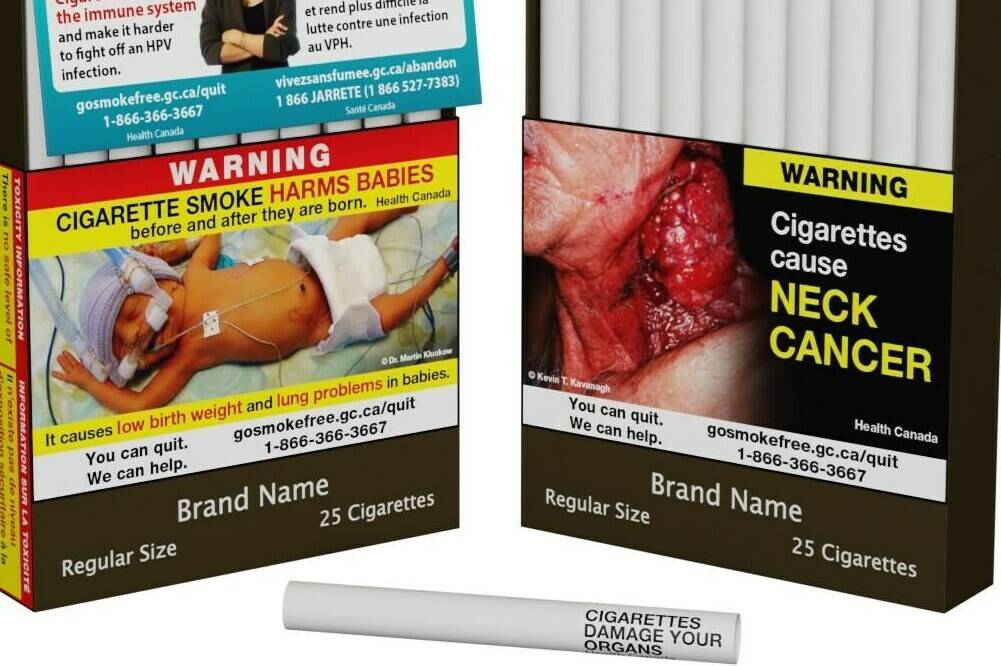Health Canada’s new regulations that require warning labels to be printed on individual cigarettes are set to come into effect this summer.
The move, first announced last year, makes Canada the first country in the world to take that step aimed at helping smokers quit the habit.
The wording on every cigarette, written in English and French, ranges from warnings about harming children and damaging organs, to causing impotence and leukemia. One caution says smoking is “poison in every puff.”
Health Canada said Wednesday (May 31), on World No Tobacco Day, that the goal of the strategy is to reach less than five per cent tobacco use by 2035 as part of new regulations that will also strengthen health-related graphic images displayed on tobacco packages.
READ MORE: Feds must enforce vaping penalties to protect kids: advocates
The regulations will come into force on Aug. 1 and will be implemented through a phased approach.
King-size cigarettes will be the first to feature the warnings and will be sold in stores by the end of July 2024, followed by regular-size cigarettes and little cigars with tipping paper and tubes by the end of April 2025, Health Canada said.
Mental Health and Addictions Minister Carolyn Bennett said tobacco use kills 48,000 Canadians every year but it will soon be impossible to avoid health warnings on every cigarette.
She said the regulator hosted a roundtable Wednesday with Canadian researchers and one from Harvard University, “and they’re all thrilled” about Canada’s approach to putting warning son each cigarette.
Tobacco use continues to be one of Canada’s most significant public health problems and is the country’s leading preventable cause of disease and premature death, Health Minister Jean-Yves Duclos said.
“Our government is using every evidence-based tool at our disposal to help protect the health of Canadians, especially young people,” he said in a statement. “Beginning next year,these new measures will help make sure that everyone across the country can receive credible information on the risks of tobacco use so they can make healthier choices for their well-being.”
Dozens of studies in Canada and elsewhere have supported the move to print warnings on each cigarette.
In a commentary published in the Canadian Medical Association Journal in 2018, researcher Crawford Moodie of the Centre for Tobacco Control Research at the University of Stirling in Scotland said that despite the prominence of warnings on cigarette packages in Canada and other countries, some smokers focus on the branding instead. He said that type of “avoidant behaviour” would be more difficult with warnings on each cigarette when smokers light it and see it in an ashtray.
Rob Cunningham, a lawyer and senior policy analyst for the Canadian Cancer Society, said he believes the new approach will provoke discussion, make cigarettes less appealing and be copied by other countries, including Australia and Norway, which cited Canada’s intention in June 2022.
“It’s going to reach kids who experiment by borrowing a cigarette from their friends. It is very cost-effective because tobacco companies pay for it. And it reaches smokers through almost 20 billion cigarettes sold each year in Canada,” Cunningham said.
“For many people who smoke, a cigarette is a permanent friend who never complains. But now there’s going to be a health warning on every cigarette. This is a very positive advance and we look forward to seeing the results.”
Tobacco advertising, promotion and sponsorship are banned in Canada and warnings on cigarette packs have existed since 1972.
In 2001, Canada became the first country to require tobacco companies to print pictorial warnings on the outside of cigarette packages and include inserts with health messages.
A second set of six warnings is expected to be printed on cigarettes in 2026.
This week, the Canadian Cancer Society, the Canadian Lung Association and the Heart and Stroke Foundation published an open letter to premiers of all 10 provinces saying they should push for initiatives to reduce smoking during settlement negotiations with three major tobacco companies that they sued years ago to recoup health-care costs.
Provinces are collectively seeking $500 billion in damages, and the three health groups said at least 10 per cent of the money from a settlement should go toward funding to slash smoking.
— With files from Laura Osman in Ottawa
Camille Bains, The Canadian Press
READ MORE: Oyama General Store wants provincial help in smoking out illegal tobacco sales

